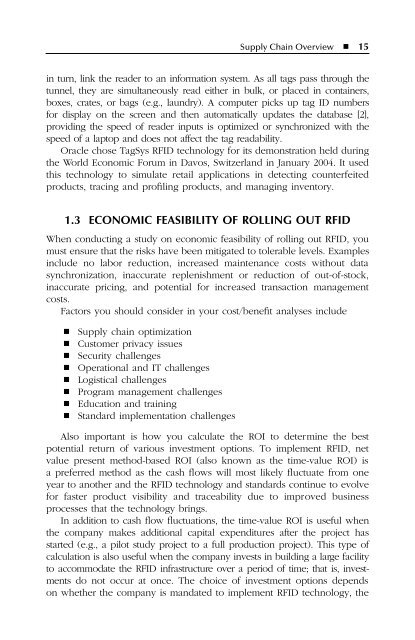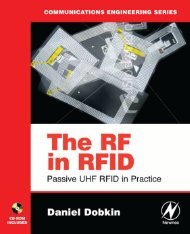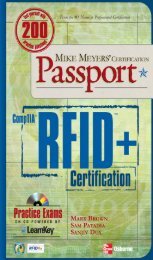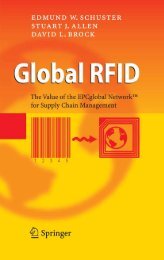- Page 2 and 3: RFID in the Supply Chain A Guide to
- Page 4 and 5: RFID in the Supply Chain A Guide to
- Page 6 and 7: TABLE OF CONTENTS Tables . . . . .
- Page 8 and 9: Table of Contents � vii 3.2.5 Cha
- Page 10 and 11: Table of Contents � ix 6.2 Securi
- Page 12 and 13: Table of Contents � xi A.8.5.3 Po
- Page 14 and 15: Table of Contents � xiii J.1.2.1
- Page 16 and 17: Table of Contents � xv Q.5.4 Enfo
- Page 18 and 19: TABLES Chapter 1 Supply Chain Overv
- Page 20: FIGURES Chapter 1 Supply Chain Over
- Page 23 and 24: xxii � RFID in the Supply Chain:
- Page 26 and 27: 1 SUPPLY CHAIN OVERVIEW This chapte
- Page 28 and 29: Supply Chain Overview � 3 the cha
- Page 30 and 31: Supply Chain Overview � 5 the ant
- Page 32 and 33: Supply Chain Overview � 7 when th
- Page 34 and 35: 1.1.3 Supply Chain Supply Chain Ove
- Page 36 and 37: Strategy Management Business proces
- Page 38 and 39: Table 1.1 RFID Markets Supply Chain
- Page 42 and 43: Supply Chain Overview � 17 interr
- Page 44 and 45: Supply Chain Overview � 19 has fi
- Page 46 and 47: Supply Chain Overview � 21 the Un
- Page 48 and 49: Supply Chain Overview � 23 Lesson
- Page 50 and 51: Retailer’s EPC IS Savant server c
- Page 52 and 53: Supply Chain Overview � 27 need d
- Page 54 and 55: Supply Chain Overview � 29 tags i
- Page 56 and 57: Supply Chain Overview � 31 When t
- Page 58 and 59: Table 1.3 Three 64-Code Versions Su
- Page 60 and 61: Supply Chain Overview � 35 back-e
- Page 62 and 63: Supply Chain Overview � 37 E-busi
- Page 64 and 65: 2 RFID TECHNOLOGY This chapter cons
- Page 66 and 67: RFID Technology � 41 deployment w
- Page 68 and 69: RFID Technology � 43 In 2003, the
- Page 70 and 71: RFID Technology � 45 Unlike passi
- Page 72 and 73: RFID Technology � 47 A Web site a
- Page 74 and 75: RFID Technology � 49 Consortium (
- Page 76 and 77: RFID Technology � 51 One possible
- Page 78 and 79: Table 2.4 Range of Intermic 2450-MH
- Page 80 and 81: RFID Technology � 55 fewer turns
- Page 82 and 83: RFID Technology � 57 self-check-o
- Page 84 and 85: Table 2.9 Global Areas by Frequency
- Page 86 and 87: RFID Technology � 61 technology i
- Page 88 and 89: RFID Technology � 63 filtered, an
- Page 90 and 91:
RFID Technology � 65 approach for
- Page 92 and 93:
RFID Technology � 67 METRO Group
- Page 94 and 95:
RFID Technology � 69 Example 1: M
- Page 96 and 97:
RFID Technology � 71 Example 6: P
- Page 98:
RFID Technology � 73 The book to
- Page 101 and 102:
76 � RFID in the Supply Chain: A
- Page 103 and 104:
78 � RFID in the Supply Chain: A
- Page 105 and 106:
80 � RFID in the Supply Chain: A
- Page 107 and 108:
82 � RFID in the Supply Chain: A
- Page 109 and 110:
84 � RFID in the Supply Chain: A
- Page 111 and 112:
86 � RFID in the Supply Chain: A
- Page 113 and 114:
88 � RFID in the Supply Chain: A
- Page 115 and 116:
90 � RFID in the Supply Chain: A
- Page 117 and 118:
92 � RFID in the Supply Chain: A
- Page 119 and 120:
94 � RFID in the Supply Chain: A
- Page 121 and 122:
96 � RFID in the Supply Chain: A
- Page 123 and 124:
98 � RFID in the Supply Chain: A
- Page 125 and 126:
100 � RFID in the Supply Chain: A
- Page 127 and 128:
102 � RFID in the Supply Chain: A
- Page 129 and 130:
104 � RFID in the Supply Chain: A
- Page 131 and 132:
106 � RFID in the Supply Chain: A
- Page 133 and 134:
108 � RFID in the Supply Chain: A
- Page 135 and 136:
110 � RFID in the Supply Chain: A
- Page 137 and 138:
112 � RFID in the Supply Chain: A
- Page 139 and 140:
114 � RFID in the Supply Chain: A
- Page 141 and 142:
116 � RFID in the Supply Chain: A
- Page 143 and 144:
118 � RFID in the Supply Chain: A
- Page 145 and 146:
120 � RFID in the Supply Chain: A
- Page 147 and 148:
122 � RFID in the Supply Chain: A
- Page 149 and 150:
124 � RFID in the Supply Chain: A
- Page 151 and 152:
126 � RFID in the Supply Chain: A
- Page 153 and 154:
128 � RFID in the Supply Chain: A
- Page 155 and 156:
130 � RFID in the Supply Chain: A
- Page 157 and 158:
132 � RFID in the Supply Chain: A
- Page 159 and 160:
134 � RFID in the Supply Chain: A
- Page 161 and 162:
136 � RFID in the Supply Chain: A
- Page 163 and 164:
138 � RFID in the Supply Chain: A
- Page 165 and 166:
140 � RFID in the Supply Chain: A
- Page 167 and 168:
142 � RFID in the Supply Chain: A
- Page 169 and 170:
144 � RFID in the Supply Chain: A
- Page 171 and 172:
146 � RFID in the Supply Chain: A
- Page 173 and 174:
148 � RFID in the Supply Chain: A
- Page 175 and 176:
150 � RFID in the Supply Chain: A
- Page 177 and 178:
152 � RFID in the Supply Chain: A
- Page 179 and 180:
154 � RFID in the Supply Chain: A
- Page 181 and 182:
156 � RFID in the Supply Chain: A
- Page 183 and 184:
158 � RFID in the Supply Chain: A
- Page 185 and 186:
160 � RFID in the Supply Chain: A
- Page 187 and 188:
162 � RFID in the Supply Chain: A
- Page 190 and 191:
6 RFID SECURITY, PRIVACY, AND RISK
- Page 192 and 193:
RFID Security, Privacy, and Risk As
- Page 194 and 195:
RFID Security, Privacy, and Risk As
- Page 196 and 197:
RFID Security, Privacy, and Risk As
- Page 198 and 199:
RFID Security, Privacy, and Risk As
- Page 200 and 201:
RFID Security, Privacy, and Risk As
- Page 202 and 203:
Figure 6.1 RFID Defense-in-Depth RF
- Page 204 and 205:
RFID Security, Privacy, and Risk As
- Page 206 and 207:
RFID Security, Privacy, and Risk As
- Page 208:
RFID Security, Privacy, and Risk As
- Page 211 and 212:
186 � RFID in the Supply Chain: A
- Page 213 and 214:
188 � RFID in the Supply Chain: A
- Page 215 and 216:
190 � RFID in the Supply Chain: A
- Page 217 and 218:
192 � RFID in the Supply Chain: A
- Page 219 and 220:
194 � RFID in the Supply Chain: A
- Page 221 and 222:
196 � RFID in the Supply Chain: A
- Page 223 and 224:
198 � RFID in the Supply Chain: A
- Page 225 and 226:
200 � RFID in the Supply Chain: A
- Page 227 and 228:
202 � RFID in the Supply Chain: A
- Page 229 and 230:
204 � RFID in the Supply Chain: A
- Page 231 and 232:
206 � RFID in the Supply Chain: A
- Page 233 and 234:
208 � RFID in the Supply Chain: A
- Page 235 and 236:
210 � RFID in the Supply Chain: A
- Page 237 and 238:
212 � RFID in the Supply Chain: A
- Page 239 and 240:
214 � RFID in the Supply Chain: A
- Page 241 and 242:
216 � RFID in the Supply Chain: A
- Page 243 and 244:
218 � RFID in the Supply Chain: A
- Page 245 and 246:
220 � RFID in the Supply Chain: A
- Page 247 and 248:
222 � RFID in the Supply Chain: A
- Page 249 and 250:
224 � RFID in the Supply Chain: A
- Page 251 and 252:
226 � RFID in the Supply Chain: A
- Page 253 and 254:
228 � RFID in the Supply Chain: A
- Page 255 and 256:
230 � RFID in the Supply Chain: A
- Page 257 and 258:
232 � RFID in the Supply Chain: A
- Page 259 and 260:
234 � RFID in the Supply Chain: A
- Page 261 and 262:
236 � RFID in the Supply Chain: A
- Page 263 and 264:
238 � RFID in the Supply Chain: A
- Page 266 and 267:
Appendix B ACTIVE RFID TECHNOLOGY W
- Page 268 and 269:
Active RFID Technology � 243 It i
- Page 270 and 271:
Active RFID Technology � 245 Logi
- Page 272 and 273:
Active RFID Technology � 247 B.5
- Page 274 and 275:
Active RFID Technology � 249 Echo
- Page 276 and 277:
Active RFID Technology � 251 A re
- Page 278 and 279:
Appendix C SEMI-PASSIVE RFID TECHNO
- Page 280:
Semi-Passive RFID Technology � 25
- Page 283 and 284:
258 � RFID in the Supply Chain: A
- Page 285 and 286:
260 � RFID in the Supply Chain: A
- Page 287 and 288:
262 � RFID in the Supply Chain: A
- Page 289 and 290:
264 � RFID in the Supply Chain: A
- Page 291 and 292:
266 � RFID in the Supply Chain: A
- Page 293 and 294:
268 � RFID in the Supply Chain: A
- Page 295 and 296:
270 � RFID in the Supply Chain: A
- Page 297 and 298:
272 � RFID in the Supply Chain: A
- Page 299 and 300:
274 � RFID in the Supply Chain: A
- Page 301 and 302:
276 � RFID in the Supply Chain: A
- Page 303 and 304:
278 � RFID in the Supply Chain: A
- Page 305 and 306:
280 � RFID in the Supply Chain: A
- Page 307 and 308:
282 � RFID in the Supply Chain: A
- Page 309 and 310:
284 � RFID in the Supply Chain: A
- Page 311 and 312:
286 � RFID in the Supply Chain: A
- Page 314 and 315:
Appendix G WAREHOUSE MANAGEMENT SYS
- Page 316 and 317:
G.2.1 Management Control Warehouse
- Page 318 and 319:
Warehouse Management Systems � 29
- Page 320:
Warehouse Management Systems � 29
- Page 323 and 324:
298 � RFID in the Supply Chain: A
- Page 325 and 326:
300 � RFID in the Supply Chain: A
- Page 327 and 328:
302 � RFID in the Supply Chain: A
- Page 329 and 330:
304 � RFID in the Supply Chain: A
- Page 331 and 332:
306 � RFID in the Supply Chain: A
- Page 333 and 334:
308 � RFID in the Supply Chain: A
- Page 335 and 336:
310 � RFID in the Supply Chain: A
- Page 337 and 338:
312 � RFID in the Supply Chain: A
- Page 339 and 340:
314 � RFID in the Supply Chain: A
- Page 341 and 342:
316 � RFID in the Supply Chain: A
- Page 343 and 344:
318 � RFID in the Supply Chain: A
- Page 345 and 346:
320 � RFID in the Supply Chain: A
- Page 347 and 348:
322 � RFID in the Supply Chain: A
- Page 349 and 350:
324 � RFID in the Supply Chain: A
- Page 351 and 352:
326 � RFID in the Supply Chain: A
- Page 353 and 354:
328 � RFID in the Supply Chain: A
- Page 355 and 356:
330 � RFID in the Supply Chain: A
- Page 357 and 358:
332 � RFID in the Supply Chain: A
- Page 359 and 360:
334 � RFID in the Supply Chain: A
- Page 361 and 362:
336 � RFID in the Supply Chain: A
- Page 363 and 364:
338 � RFID in the Supply Chain: A
- Page 365 and 366:
340 � RFID in the Supply Chain: A
- Page 367 and 368:
342 � RFID in the Supply Chain: A
- Page 369 and 370:
344 � RFID in the Supply Chain: A
- Page 372 and 373:
Appendix L PARTITIONING LARGE DATAB
- Page 374 and 375:
Partitioning Large Databases: Oracl
- Page 376:
Partitioning Large Databases: Oracl
- Page 379 and 380:
354 � RFID in the Supply Chain: A
- Page 381 and 382:
356 � RFID in the Supply Chain: A
- Page 383 and 384:
358 � RFID in the Supply Chain: A
- Page 385 and 386:
360 � RFID in the Supply Chain: A
- Page 388 and 389:
Appendix O COMMERCIAL ASSESSMENT PR
- Page 390 and 391:
Appendix P RISK-RELATED SOFTWARE Ac
- Page 392 and 393:
Risk-Related Software � 367 that
- Page 394 and 395:
Risk-Related Software � 369 to op
- Page 396 and 397:
Risk-Related Software � 371 Devel
- Page 398 and 399:
Murdoch University Perth, WA 6150,
- Page 400:
Risk-Related Software � 375 U.S.
- Page 403 and 404:
378 � RFID in the Supply Chain: A
- Page 405 and 406:
380 � RFID in the Supply Chain: A
- Page 407 and 408:
382 � RFID in the Supply Chain: A
- Page 409 and 410:
384 � RFID in the Supply Chain: A
- Page 411 and 412:
386 � RFID in the Supply Chain: A
- Page 413 and 414:
388 � RFID in the Supply Chain: A
- Page 415 and 416:
390 � RFID in the Supply Chain: A
- Page 417 and 418:
392 � RFID in the Supply Chain: A
- Page 419 and 420:
394 � RFID in the Supply Chain: A
- Page 421 and 422:
396 � RFID in the Supply Chain: A
- Page 423 and 424:
398 � RFID in the Supply Chain: A
- Page 425 and 426:
400 � RFID in the Supply Chain: A
- Page 427 and 428:
402 � RFID in the Supply Chain: A
- Page 429 and 430:
404 � RFID in the Supply Chain: A
- Page 431 and 432:
406 � RFID in the Supply Chain: A
- Page 433 and 434:
408 � RFID in the Supply Chain: A
- Page 435 and 436:
410 � RFID in the Supply Chain: A
- Page 437 and 438:
412 � RFID in the Supply Chain: A
- Page 439 and 440:
414 � RFID in the Supply Chain: A
- Page 441 and 442:
416 � RFID in the Supply Chain: A
- Page 443 and 444:
418 � RFID in the Supply Chain: A
- Page 445 and 446:
420 � RFID in the Supply Chain: A
- Page 447 and 448:
422 � RFID in the Supply Chain: A
- Page 449 and 450:
424 � RFID in the Supply Chain: A






